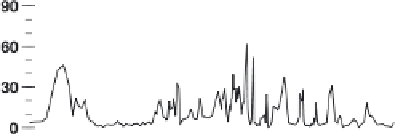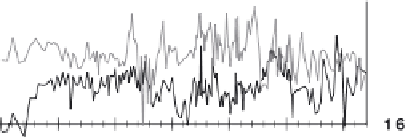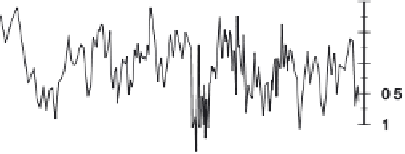Geoscience Reference
In-Depth Information
South of the Arctic Front at site MD95-2041 (Plate 2), the
planktic
δ
18
O and for G. bulloides and N. pachyderma (r)
13
C records show distinct millennial-scale oscilla-
tions that were related to the Greenland stadial/interstadial
cycles 18 to 20. During all the interstadials, warming is
observed in the surface to subsurface waters (Plates 2a and
2b). Conditions in the subsurface waters appear to have been
very stable, and the
δ
also, the
δ
18
O values of all three deep-dwelling
species were close together (Plate 2b). Thus, subsurface
water conditions on the southwestern Iberian margin were
more stable during MIS 4 than during MIS 2. Seasonality
(Plate 2d) seems to have been a bit more variable at site
MD95-2041 than at MD95-2040 and increased during
Greenland stadial 19. During this stadial, percent N. pachy-
derma (s) rose slightly (Plate 2c), and
13
CofN. pachyderma
(r) and G. bulloides (Plate 2f) indicated fewer nutrients in the
surface waters. Since this site was highly influenced by
upwelling with increased productivity during some of the
MIS 2 stadials [Voelker et al., 2009], all these signals are
interpreted as being upwelling related.
Overall, hydrographic conditions north and south of the
front were similar during MIS 4 and 2, respectively. Differ-
ences between the two glacial periods were more restricted to
the subsurface waters, especially the ENACW
st
, where con-
ditions were more stable during the older glacial period. The
presence of ENACW
st
and in sections also of G. ruber white
indicate that AzC-derived waters were present during much
of the glacial periods, even if potentially restricted to a
circulation pattern similar to the modern winter circulation
(Figure 1a). This further implies that the Azores Front most
likely extended toward the southern Iberian margin during
both MIS 2 [Rogerson et al., 2004] and 4 and might be the
front observed between 38°N and 40°N.
δ
6.2. The Penultimate Glacial: MIS 6
Figure 6.
Vertical gradients in the upper water column at site
MD95-2040 during MIS 6 [de Abreu et al., 2003; this study].
(a) The
δ
As already indicated by the percent N. pachyderma (s)
evidence discussed in section 5.3, MIS 6 differed from the
two younger glacial periods. This is further supported by the
multispecies stable isotope evidence of cores MD95-2040
(Figure 6) and MD01-2443 (Figure 7). The subtropical spe-
cies G. ruber white was always present at the southern
location and nearly continuously also at site MD95-2040,
indicating a northward heat transport stronger than during the
last glacial cycle. This heat
18
O records of surface to thermocline dwelling species
G. ruber white (dark gray, Grw), G. bulloides (black, Gb), and N.
pachyderma (r) (light gray, Npr). (b) The
δ
18
O records of winter
mixed layer species G. inflata (black, Gi) and deep-dweller G.
truncatulinoides (r) (light gray and triangles, Gtr). (e and f) Respec-
tive
δ
13
C values. (c) Percent N. pachyderma (s) data. (d) Difference
between
δ
18
OofG. bulloides reflecting
seasonality. Gray bars mark periods with increased seasonality.
Numbers refer to MIS substages; H11 is Heinrich event 11.
18
OofG. inflata and
δ
flux most likely occurred with the
IPC, similar to the LGM [Eynaud et al., 2009; P
aumann et
al., 2003; Voelker et al., 2009]. Ventilation of those waters
was, however, highly variable (Figure 6e), much more so
than during any of the younger glacial periods. Seasonality
variations (Figure 6d), on the other hand, were much higher
than during MIS 2 and 4 (Plate 1d). Seasonal contrasts were
driven by the relatively more stable conditions in the winter
mixed layer (Figure 6b). Longer-lasting seasonality extremes
were associated with Heinrich event 11, similar to the youn-
ger Heinrich stadials and occurred during the intervals from
158.9 to 163 ka and from 168.2 to 173.2 ka, while shorter




















































































Search WWH ::

Custom Search